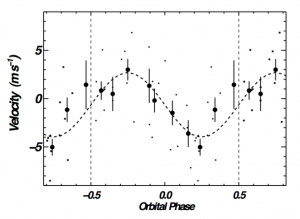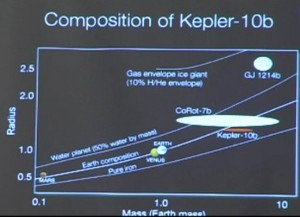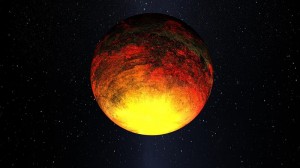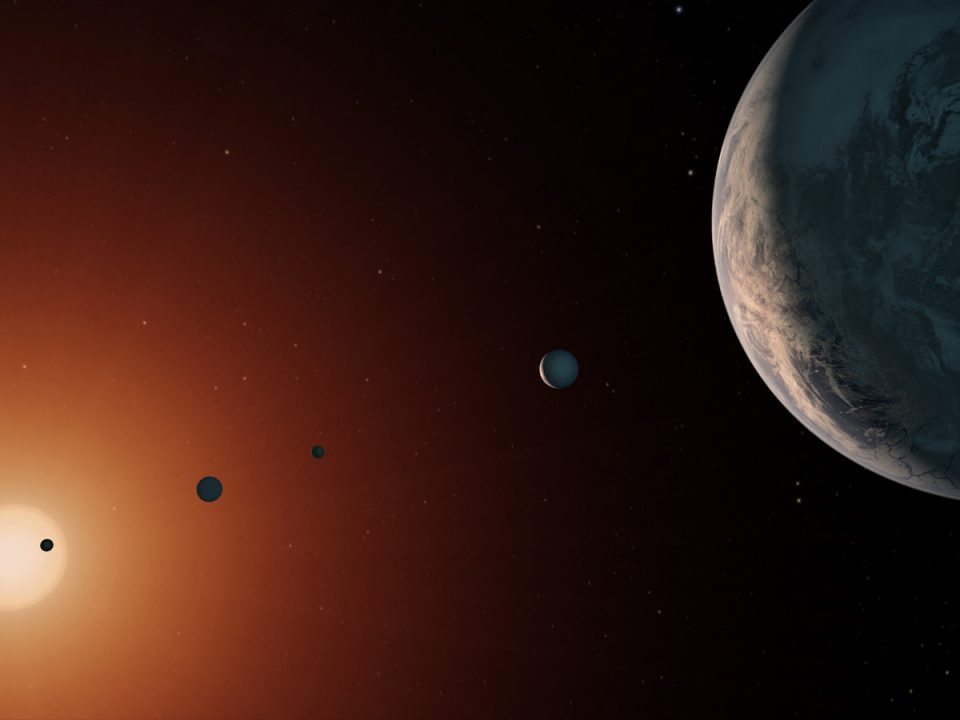Kepler-10b – The first unambiguous rocky exoplanet
Quiescent volcanic activity on Io in November 2010
December 8, 2010A landslide of Kepler Exoplanet Candidates
February 2, 2011It is done. The Kepler team finally announced the discovery of its first terrestrial exoplanet. A referred journal, accepted in the Astrophysical journal (here) by Natalie Batalha and a large number of colleagues, describes this new member of the exoplanet family. This is the 519th known exoplanet based on the Extra-solar Planets Catalog, but definitely a special one.

Skychart showing the position of KIC 11904151, a faint (11th magnitude in visible) sun-like star located at 172 pc in the constellation of Cygnus which hosts Kepler-10b and a potential additional exoplanet. (generated using the WorldWide Telescope software)
This new exoplanet, named Kepler-10b orbits around a Sun-like star, twice the age of our sun (~12 Gyrs) but similar in size and color. This main-sequence star is identified as KIC 11904151, one of the 13.2 million stars of the Kepler Input Catalog and it is located at 173 pc (576 light-years) from us. Thanks to the Kepler accurate photometric capabilities and its automatic pipeline module, a small and periodic (P~20h) attenuation of the star lasting 1.8 h and with an intensity of 0.015% was detected on a regular basis starting from May 13 2009. Several hundred detections were detected. A second, long-period (45h) and more intense (0.038%), attenuation was also seen 6 times by manual inspection starting on May 19 2009
Additional observations from ground-based telescopes using high resolution spectroscopy and high-angular resolution provided by speckle and adaptive optics techniques allow the team to confirm that these attenuations are indeed due to the presence of exoplanets orbiting around this star.

Doppler effect measurement recorded using HIRES instrument at W.M. Keck Observatory showing the wobbling of the star due to Kepler-10b (Credit: Betalha et al. 2010, in press Astrophysical Journal)
Doppler effect (the “wobbling of the star”) with an amplitude of ~3 m/s due to the closer planet was detected using the W.M. Keck II telescope from observations collected in May-August 2009. These remarkably accurate data confirmed the genuineness of the closer planet and allowed constraining the mass of the planet. The team announced today at the AAS the discovery of Kepler-10b, a Earth-like exoplanet 5 times more massive than Earth, 1.5 larger than Earth and most likely made of rocky/iron material since its density is between 6 and 11 g/cc.
The second transit name KOI-72.02 has not yet been confirmed by radial velocity, most likely because the exoplanet candidate is too far and/or too small. Its mass should be less than 20 Earth Mass, it is twice the size of Earth and orbits at 0.24 AU from its sun, 2/3 the distance of Mercury around our Sun.
For the sake of completeness and to give a broad context, it is not the first time that a rocky exoplanet has been claimed to be discovered. I mentioned in one of my previous posts the detection of Corot-7b (R~1.6 x Rearth; M ~ 5 x Mearth), discovered by transit in 2009 using the COROT mission, which has a bulk density from 0 to 11 g/cc. GJ1214b is another example of transiting super-Earth planet, almost 3 time larger than Earth and with a density of 1.9 g/cc. Small, but exotic exoplanets, were also discovered around the pulsar PSR B1257+12 with a mass of less than four time Earth Mass.

Slide from N. Betalha presentation presented at the 217th AAS press conference showing the accurate density measurement of Kepler-10b, placing it as an Earth-like or Iron-core exoplanet. (credit: D. Fisher)
The figure above was captured by Daniel Fisher (@cosmos4u) during the presentation of Natalie Batalha at the Press Conference of the 217th AAS today at Seattle, WA. The uncertainty in the density of Corot-7b is quite large, so it is impossible to know if COROT-7b is a water planet, a rocky planet or an iron-core planet. The measurement of density of Kepler-10b is obviously more accurate, implying that the exoplanet has a composition similar to Earth or an iron-core planet. Kepler-10b is the first unambiguous detection of a rocky exoplanet, and the first super-Earth discovered around a sun-like star. This is obviously a significant step in the search for exo-worlds and for the Kepler team, and also a major achievement since it was the main objective of this mission.
What’s next?
It is remarkable that a few days of observations after the commissioning phase of the telescope (which ended on May 12 2009) already permitted the detection of this first rocky planet. Today we have one unambiguous Earth-like exoplanet, but how many of them could we expect to find after a year of survey which includes several hundred thousands of stars? I am guessing that we will get a response in a few weeks or months.
Franck Marchis @AllPlanets on Twitter
Update: a better version of Betalha’s slide can be found on the Kepler-10b web site




3 Comments
Welcome back
Congratulations for your post… Sure, Kepler-10b is a genuine earthly-like planet … but located at 576 light-years! When the new objective to exceed speed light?
Absolutely Dorina. Vigilance should be our watch word in the digital age. Imagine 24.5million online fraud last year alone, which is frightening. We should not be caught up at all. Many thanks for visiting our site.s All the best to you always.